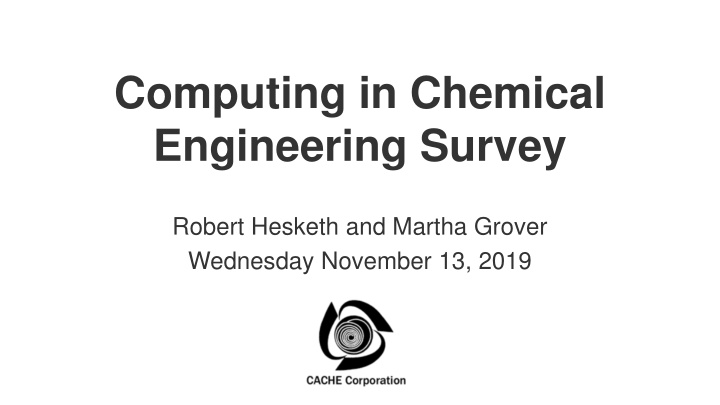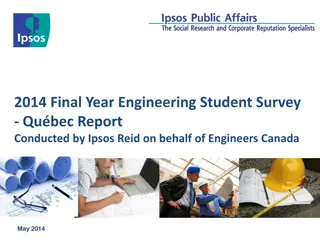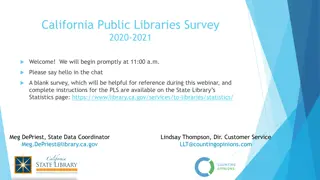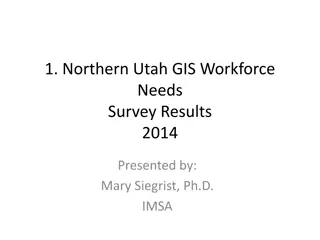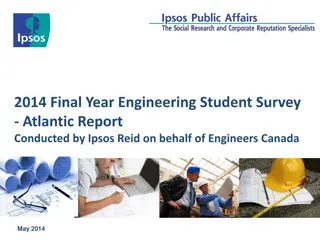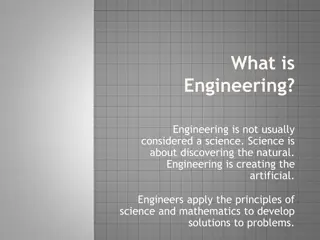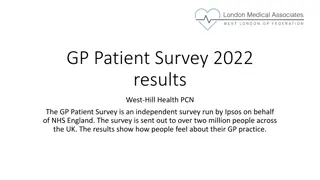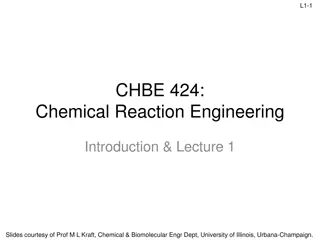Computing in Chemical Engineering Survey Results
This survey explores how computing is taught in chemical engineering curriculum at universities, covering topics such as programming languages, statistics courses, software integration, and student preparedness in using computer software for problem-solving. The findings provide insights on faculty perceptions and identify barriers to effective use of computer aids in undergraduate education.
Download Presentation

Please find below an Image/Link to download the presentation.
The content on the website is provided AS IS for your information and personal use only. It may not be sold, licensed, or shared on other websites without obtaining consent from the author.If you encounter any issues during the download, it is possible that the publisher has removed the file from their server.
You are allowed to download the files provided on this website for personal or commercial use, subject to the condition that they are used lawfully. All files are the property of their respective owners.
The content on the website is provided AS IS for your information and personal use only. It may not be sold, licensed, or shared on other websites without obtaining consent from the author.
E N D
Presentation Transcript
Computing in Chemical Engineering Survey Robert Hesketh and Martha Grover Wednesday November 13, 2019
Survey and Summary of Responses This survey is in two parts: Industry: 307 responses from ChE s in the chemical industry University: 154 responses from 70 chemical engineering departments Previous surveys in 1997 and 2003 did not survey faculty or students at universities. 3/12/2025 2
Computing in Chemical Engineering: Universities Questions asked: How is computing taught in the curriculum? Is it effective? What are the needs?
How is computing taught in the curriculum? Is computer programming taught to your chemical engineering students? Programming is taught by chemical engineering faculty.
How is computing taught in the curriculum? What language is taught? Python is new since previous surveys, MATLAB is not.
How is computing taught in the curriculum? What courses cover statistics or data analytics? Statistics or data analytics is required.
How is computing taught in the curriculum? Is there integration of software between courses? Students are learning multiple software packages.
How well are our students prepared? Do you agree with the statement, Graduates are well prepared to use computer software and programming to solve engineering problems? Just over half of faculty believe that students are well prepared.
What are the needs? What are the barriers that faculty have for not using computer aids effectively in your undergraduate curriculum?
What are the needs? What method do you use to introduce students to the computational software that you use in your classes?
Computing in Chemical Engineering Survey: Industry 307 Total Responses Date Created: Monday, November 12, 2018 Complete Responses: 307 Powered by
No respondents had an MS degree! Education: (Please select your highest degree) 80.00% 70.00% 60.00% 50.00% B.S. / B.Eng. M.S. / M.Eng. 40.00% Ph.D or Sc.D. 30.00% Other (please specify) 20.00% 10.00% 0.00% Total Powered by
Computing in Industry comparison with previous years Year R & D Plant/Process Support Process Design/Analysis Process Control Administrative Systems Other 2019 25% (75) 18% (55) 2003 25% (69) 22% (60) 1997 18% 21% 29% (88) 18% (48) 20% 3% (10) 11% (33) 8% (21) 5% (13) 2% (6) 21% (58) 16% 13% 8% 15% (45) Powered by
Q3: Professional Experience Answered: 306 Skipped: 1 PhD had 35% over 21 years BS had 45% under 5 years 40% 30% None <5 years. 5-10 years 20% 11-15 years 16 - 20 years 10% over 21 years 0% Total Powered by
Q4: Which of the following is most appropriate for your industry? Please rank these from 1 being the most important and 4 least important. Chose N/A if the choice is not applicable for your industry. Answered: 304 Skipped: 3 Using computer applications most important 70% 60% 2 50% 40% 3 Programming 30% Machine learning 4 Least Important 4 20% 3 3 10% 2 2 N/A 1 1 0% Q2: B.S. / B.Eng. Q2: Ph.D or Sc.D. Q2: B.S. / B.Eng. Q2: Ph.D or Sc.D. Total Powered by
Q4: Which of the following is most appropriate for your industry? Please rank these from 1 being the most important and 4 least important. Chose N/A if the choice is not applicable for your industry. Answered: 304 Skipped: 3 Most Important 2 Programming 50% 40% 3 30% Machine learning Least Important N/A 4 20% 3 2 10% 1 Q2: B.S. / B.Eng. Q2: Ph.D or Sc.D. Powered by 0%
Q4: Which of the following is most appropriate for your industry? Please rank these from 1 being the most important and 4 least important. Chose N/A if the choice is not applicable for your industry. Machine learning 50% Most Important 2 3 Least Important N/A 40% 30% 20% 10% 0% Powered by Total
Please rank the primary tasks that require the use of spreadsheet software. (1 high usage and 5 is low usage) If Excel is not used for these type of calculations check the "not used box". 2019 is the addition of those that chose 1 and 2 out of 5 2019 2003 Process data analysis (collection and statistical analysis) 70% (213) 88.2% (253) 38% (114) 23.7% (68) 36% (108) Economic studies (inventory/accounting) Engineering design calculations Material and energy balance calculations (process analysis) Numerical analysis (multiple algebraic-equation systems, integration, differential equations, etc.) 28% (85) 25.1% (72) 13% (38) 47.4% (136) From 2003 survey: Other (e.g., reporting, financial modeling, emissions calculations, etc.) 16.7% (48) Powered by
Q7 What type of software packages do you use in your work? Comparison with 2003 70% Dedicated statistical analysis software (SAS, MiniTab, JMP, SPSS, etc.) 60% Numerical analysis software (MATLAB, POLYMATH, MathCad, Octave, COMSOL) 50% 40% Database management systems (MS Access, Oracle, SQL) 30% 20% Symbolic and mathematical manipulation software (Mathematica, Maple, MathCAD) 10% Numerical methods libraries (IMSL, DASSL, LAPACK, etc.) 0% 2019 2003 Powered by
Use of Process Simulators Comparison between 2003 and 2019 I don't use a chemical process simulator in my work AspenPlus 70% 60% 50% AspenHysys 40% ProSim 30% CHEMCAD 20% gPROMS 10% 0% SuperPro Designer 2019 2003 Powered by
Q9: How strongly do you agree with this statement, "I was adequately educated at my university to use and understand chemical process simulation programs." 2019 56% 17% 2003 49% 22% Answered: 305 Skipped: 2 Yes No No 50% Strongly agree 40% Agree Opinion 12% 29% 30% Neither agree nor disagree Disagree 20% Universities preparation for use of chemical process simulators hasn t changed 10% Strongly disagree 0% Total Powered by
Q11: When training is required for a software program, rate the training method that you used. Answered: 299 Skipped: 8 How do you learn new software? Mostly Self Taught and Colleagues 2003 71% 14% 1997 58% 16% 2019* 83% 58% Self-taught Colleagues Company provided training program COthers (Training Companies, Tool Vendor, School, etc.) 25% 9% 16% 28% 6% 10% 2019* Combined Primary source & used many times Powered by
Q14: Do you write computer programs at work to solve engineering problems? If so what language do you use? Answered: 303 Skipped: 4 50% I don't write computer programs at work to solve engineering problems Python 45% 40% MATLAB Visual Basic .NET 35% Rust 30% SQL 25% C++ 20% Fortran 77 or 90 15% Shift to Python and MATLAB for programming languages Java 10% JavaScript 5% C 0% Total Powered by
Q15: How strongly do you agree with this statement? "Your new chemical engineering hires have sufficient education in statistics and data analytics." Answered: 303 Skipped: 4 Strong difference between PhD and BS opinion 50% 45% 40% 35% Strongly agree 30% Agree 25% Neither agree nor disagree 20% Disagree 15% Strongly disagree 10% 5% 0% Q2: B.S. / B.Eng. Q2: Ph.D or Sc.D. Powered by
Conclusions Chemical Engineers predominately use computer programs in their work. Computer programming in industry is not a major task done by ChE s. Excel is a major tool used by ChE s in industry. The use of Statistical and Numerical Analysis software has increased in use by ChE s in industry. The use of MATLAB and Python has increased from 2003. Machine Learning and Statistics and Data Analytics is an area that is expected to grow in the future. We need to evaluate the effectiveness of our teaching of this subject. The effective use of Python and data analytics are emerging opportunities in education. Software tutorials are needed that faculty, students, and industry could use. Powered by
